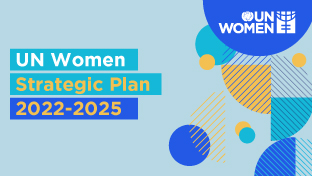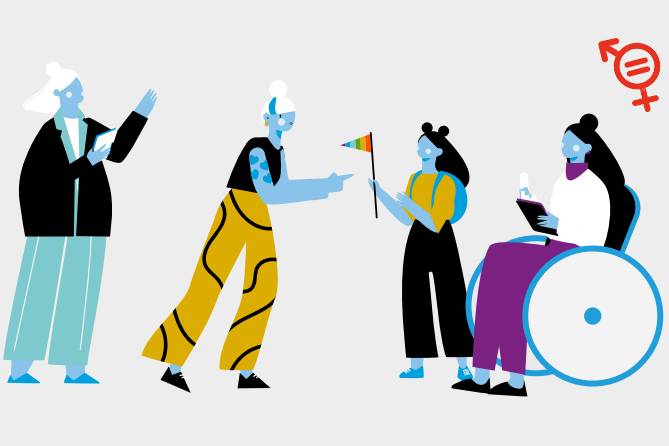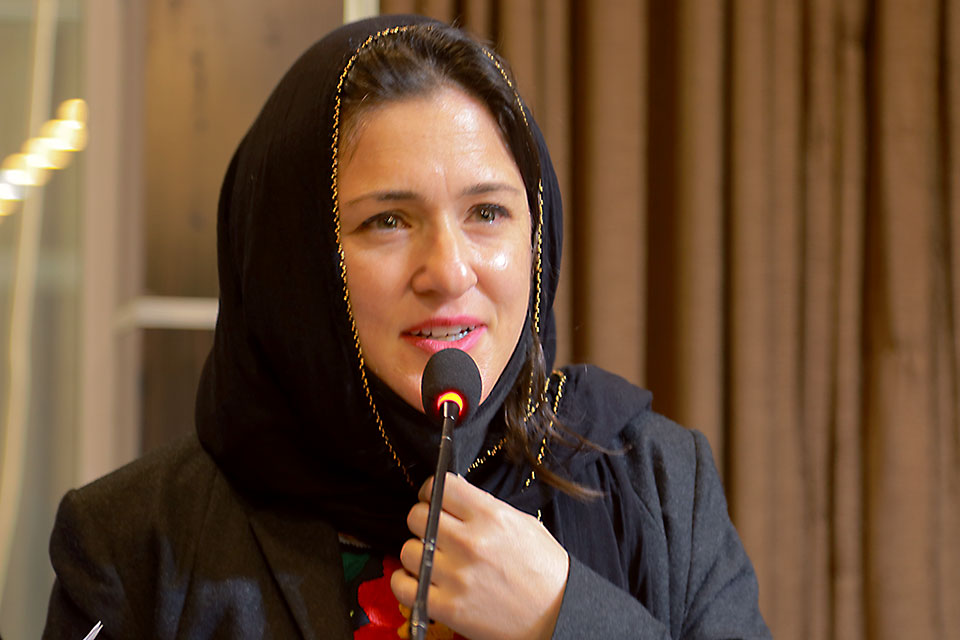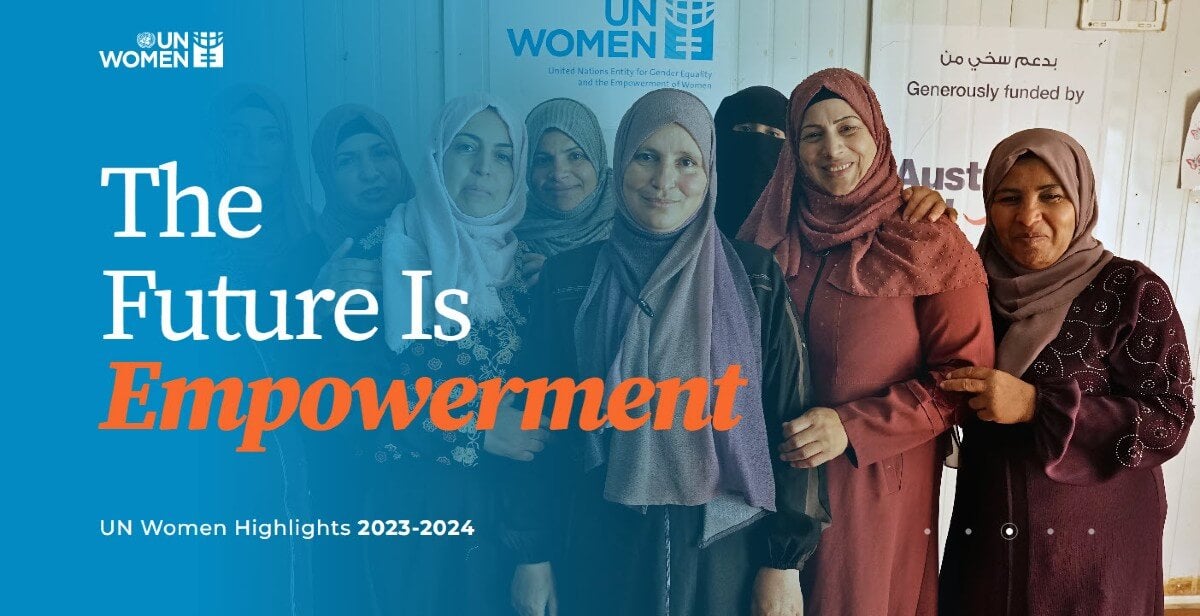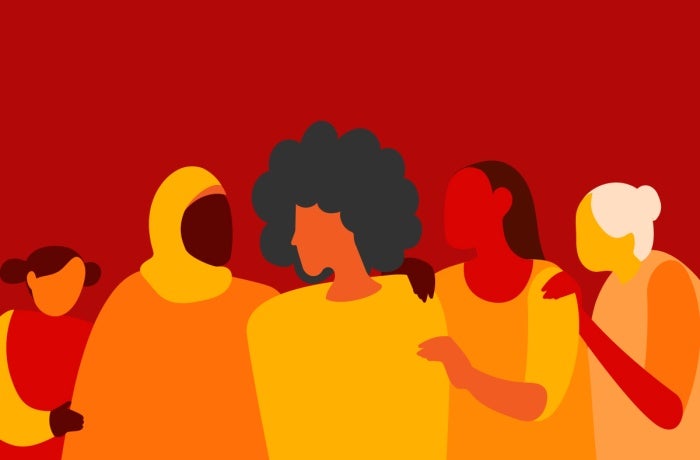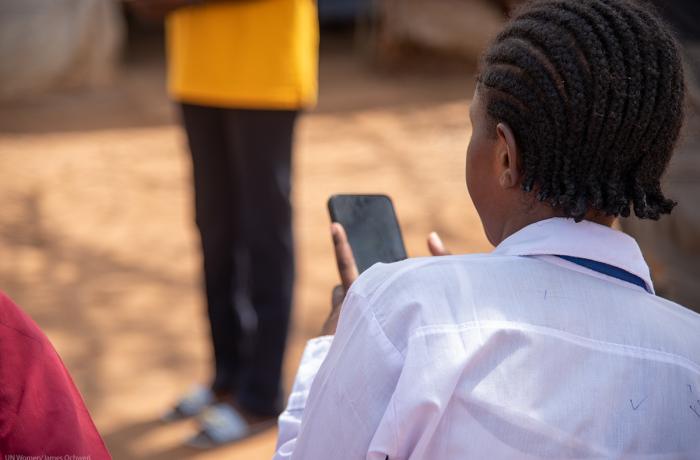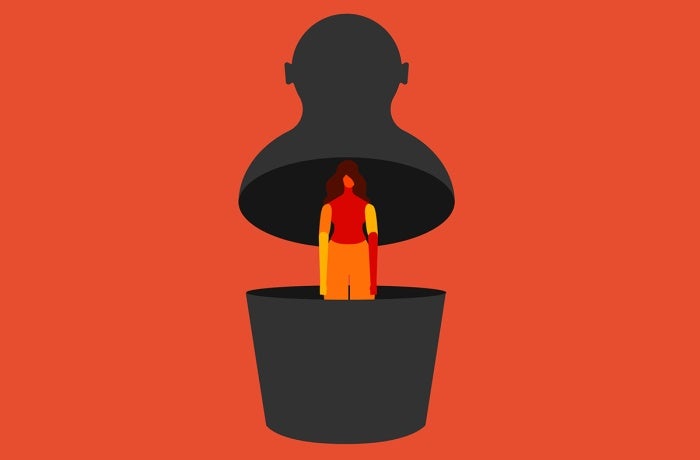Facts and figures: Ending violence against women

The availability of data on violence against women and girls has improved considerably in recent years and data on the prevalence of intimate partner violence is now available for at least 161 countries. Please visit our research and data page to better understand how data is crucial to UN Women’s work on preventing and responding to violence against women and girls.
- Prevalence of violence against women and girls
- Femicides/Feminicides
- Risk factors of violence against women and girls
- Climate change, health, and humanitarian crises fuel violence against women and girls
- Sexual violence against women and girls
- Human trafficking and exploitation of women
- Violence against girls
- Female genital mutilation
- Technology-facilitated violence against women and girls
- Violence against women in public life
- Reporting of violence against women
- Laws on violence against women and girls
- Funding to end violence against women and girls
- Economic cost of violence against women and girls
Prevalence of violence against women and girls
- Global scale of violence against women: An estimated 736 million women—almost one in three—have been subjected to physical and/or sexual intimate partner violence, non-partner sexual violence, or both at least once in their life (30 per cent of women aged 15 and older). This figure does not include sexual harassment. Women who have experienced violence are more likely to suffer from depression, anxiety disorders, unplanned pregnancies, sexually transmitted infections and HIV, with long-lasting consequences.
- Violence by intimate partners: Most violence against women is committed by current or former husbands or intimate partners. More than 640 million women aged 15 and older (26 per cent) have been subjected to intimate partner violence.
Femicides/Feminicides
- In 2022, around 48,800 women and girls worldwide were killed by their intimate partners or other family members. This means that, on average, more than five women or girls are killed every hour by someone in their own family.
- While 55 per cent of all female homicides are committed by intimate partners or other family members, only 12 per cent of all male homicides are perpetrated in the private sphere.

Every 10 minutes a women is killed
#NoExcuse. UNiTE to End Violence against Women.
Risk factors of violence against women and girls
Women who suffer multiple forms of discrimination face a higher risk of violence and are more vulnerable to its consequences.
- Violence against adolescent girls: are more at risk of intimate-partner violence than adult women. By the time they are 19 years old, almost 1 in 4 adolescent girls (24%) who have been in a relationship have already been physically, sexually, or psychologically abused by a partner.
- Partner violence and gender inequality in the Caribbean: A regional analysis of Women’s Health Surveys conducted in five CARICOM Member States – Grenada, Guyana, Jamaica, Suriname, and Trinidad and Tobago – from 2016 to 2019 found that ever-partnered women aged 15-64 who were in relationships with men who had beliefs that reinforce male dominance and gender inequality were more likely to have experienced lifetime and current domestic violence. Behaviours intended to control women’s bodies, autonomy and contact with others are also strongly correlated with an increased experience of intimate partner violence.
- Women with disabilities report a higher rate of all forms of intimate partner violence than women without disabilities. A recent review confirmed a strong link between disability and increased risk of violence. A study conducted in the European Union revealed that women with disabilities faced higher risks of experiencing violence, and that the risk was even higher for women with disabilities on a low income.
Climate, health, and humanitarian crises fuel violence against women and girls
Interlocking crises including economic crises, conflicts, and climate change are intensifying gender-based violence with marginalized women facing disproportionate and multiple forms of intersecting discrimination.
- Climate change and environmental degradation increase the risks of violence against women and girls due to displacement, resource scarcity and food insecurity, and disruption to services for survivors:
- It is estimated that 80 per cent of people displaced by climate change are women.
- After Hurricane Katrina in 2005, the rate of rape among displaced women displaced rose 6 times the baseline rate in Mississippi for that year.
- Following the Canterbury earthquake, New Zealand police reported a 53% rise in domestic violence.
- In Ethiopia there was an increase in girls sold into early marriage in exchange for livestock to help families cope with the impacts of prolonged droughts.
- Nepal witnessed an increase in trafficking from an estimated 3,000-5,000 annually in 1990 to 12,000-20,000 per year after the 2015 earthquake.
- Humanitarian contexts have a severe impact on the safety of women with 70 per cent of women experience gender-based violence (GBV) in humanitarian contexts compared with 35 per cent worldwide.
- Child marriage rates are 4 percentage points higher in conflict-affected areas.
- In Afghanistan, by July 2024, 64 per cent of women reported feeling “not at all” safe leaving home by themselves, compared to 2 per cent of men. Eight per cent of the surveyed women claimed they knew at least one woman or girl who has attempted suicide in the last three years.
- In Haiti, 8% of women in camps said they had resorted to sex work/prostitution to meet their needs at least once, and an additional 20.6% reported knowing at least one person who had done so.
- Displacement and gender-based violence: Forcibly displaced women in Colombia and Liberia were at 40% and 55% greater risk, respectively, of experiencing intimate-partner violence in the past year compared to non-displaced women.
Sexual violence against women and girls
- Non-partner sexual violence: Globally, 6 per cent of women report they have been subjected to sexual violence from someone other than their husband or partner. However, the true prevalence of non-partner sexual violence is likely to be much higher, considering the particular stigma surrounding this form of violence.
- Adolescent girls at risk of sexual violence: Around 15 million adolescent girls worldwide, aged 15–19 years, have experienced forced sex. In the vast majority of countries, adolescent girls are most at risk of forced sex (forced sexual intercourse or other sexual acts) by a current or former husband, partner, or boyfriend. Based on data from 30 countries, only one per cent have ever sought professional help.
Human trafficking and exploitation of women
- In 2020, for every 10 victims of human trafficking detected globally, four were adult women and two were girls.
- Ninety-one per cent of trafficking victims for sexual exploitation are females. Analysis of court cases shows that female victims are subjected to physical or extreme violence at the hands of traffickers at a rate three times higher than males.
Violence against girls
- Decline in global rate of child marriage: The global proportion of women aged 20–24 years who were married before the age of 18 dropped from nearly one in four in 2010 to almost one in five (19 per cent) in 2022. However, to end child marriage by 2030 progress needs to accelerate 20 times the current rate. If no progress is made, 9 million girls will marry in childhood in the year 2030, with girls from the poorest and most marginalized communities disproportionately affected.
- School-related gender-based violence: Globally, one in three students, aged 11–15, have been bullied by their peers at school at least once in the past month, with girls and boys equally likely to experience bullying. While boys are more likely to experience physical bullying than girls, girls are more likely to experience psychological bullying, and they report being made fun of because of how their face or body looks more frequently than boys.
Female genital mutilation
Female genital mutilation (FGM) remains a deeply entrenched practice affecting millions of women and girls worldwide. Despite global efforts to eliminate it, FGM continues to pose severe health risks, violate fundamental human rights, and perpetuate gender inequality, particularly in parts of Africa and the Middle East.
- Over 230 million girls and women have undergone female genital mutilation, representing a 15% increase—or 30 million more girls and women—compared to data from eight years ago.
- In sub-Saharan Africa, 1 in 4 women and girls has undergone female genital mutilation. But levels vary widely across countries. There are still countries where female genital mutilation is almost universal; where at least 9 in 10 girls and women, aged 15–49 years, have been cut, while it affects no more than 1% of girls and women in Cameroon and Uganda.
Technology-facilitated violence against women and girls
The lack of a common definition for technology-facilitated violence against women and girls makes it challenging to collect comparable global data. However, country and regional studies reveal alarmingly high rates of online harassment and abuse:
- One in 10 women in the European Union report having experienced cyber-harassment since the age of 15. This included having received unwanted and/or offensive sexually explicit emails or SMS messages, or offensive and/or inappropriate advances on social networking sites.
- In the Arab States, a regional study found that 60 per cent of women internet users in the region had been exposed to online violence in the past year.
- In the Western Balkans and Eastern Europe countries, more than half of women present online in the region have experienced some form of technology-facilitated violence in their lifetime.
- In Uganda, in 2021, about half of the women (49%) reported to have ever been involved in online harassment.
- According to a 2016 survey by the Korean National Human Rights Commission, 85 per cent of women experienced hate speech online.
Violence against women in public life
Women in public life, including parliamentarians and journalists, face high levels of psychological violence, harassment, and threats, often tied to their gender. These forms of violence not only threaten their personal safety but also hinder gender equality and democratic participation.
- Violence against women lawmakers:
- Across five regions, 82 per cent of women parliamentarians reported having experienced some form of psychological violence while serving their terms. This included remarks, gestures, and images of a sexist or humiliating sexual nature, threats, and mobbing.
- Social media is the main platform for this type of abuse, with nearly half (44 per cent) of women lawmakers reporting receiving death, rape, assault, or abduction threats towards them or their families.
- Sixty-five per cent of women parliamentarians reported being subjected to sexist remarks, primarily by male colleagues in parliament.
- Violence against women journalists:
- A global survey revealed that 73% of women journalists have experienced online violence.
- 20% said they had been attacked or abused offline in connection with online violence they had experienced.
- The reporting theme most often linked to heightened attacks on women journalists was gender (49%), followed by politics and elections (44%), and human rights and social policy (31%).
Reporting of violence against women
- Less than 40 per cent of the women who experience violence seek help of any sort. In the majority of countries with available data on this issue, women who do seek help look to family and friends and very few seek support from formal institutions, such as police and health services.
- Less than 10 per cent of those seeking help appealed to the police.
Laws on violence against women and girls
- Limited legal protection: In 2022, only 14 per cent of all women and girls—about 557 million—were living in countries with robust legal protection to guarantee women’s fundamental human rights.
- Impact of domestic violence legislation:
- Countries with domestic violence legislation have lower rates of intimate partner violence than those without such legislation (9.5% compared to 16.1%)
- 151 countries have laws on sexual harassment in employment, but only 39 have laws prohibiting sexual harassment in public spaces.
- Of the 165 countries with domestic violence laws, only 104 countries have comprehensive legislation addressing domestic violence.
- New legislation in 2023:
- In 2023, Lesotho, Togo and Uzbekistan enacted legislation protecting women from various forms of domestic violence.
- Armenia, Equatorial Guinea, Jordan, Moldova and Suriname enacted legislation on sexual harassment in employment.
- Gaps in legislation:
- Over 60% of countries still lack rape laws based on the principle of consent.
- Less than half of the global population of women are protected by laws against cyber harassment.
- Overall, 139 countries lack adequate legislation prohibiting child marriage.
Funding to end violence against women and girls
- Tracking budget allocation for gender equality: As of 2023, only 27 countries have comprehensive systems to track and make budgetary allocations for gender equality and women’s empowerment.
- Decline in funding to end violence against women:
- Despite an increase in Official Development Assistance (ODA) funding over the last five years, funding to end violence against women has fallen 13% between 2018-2019 and 2020-2021.
- 99% of gender-related ODA does not reach local women’s rights organizations and feminist movements.
- Only about 5% of the total OECD member states funding for ending violence against women and girls is allocated to civil society organizations.
Economic costs of violence against women and girls
Violence against women incurs significant costs to the state, to victims/survivors, and communities. Costs are both direct and indirect, and tangible and intangible. For example, the costs of the salaries of individuals working at shelters are direct tangible costs. Costs are borne by everyone, including individual victims/survivors, perpetrators, the government and society in general. Here are some examples of the economic toll of gender-based violence across the world:
- In Viet Nam, the combined costs of out of pocket expenditures and lost earnings due to violence represent nearly 1.41% of the GDP. Women experiencing violence earn 35 per cent less than those who have not, highlighting another significant drain on the national economy.
- In Egypt, an estimated 500,00 working days are lost each year due to marital violence and the health sector bears over USD 14 million in costs to serve just one quarter (600,000) of survivors.
- In Morocco, the total annual cost of physical and/or sexual violence against women was estimated at 2.85 billion dirhams (around USD 308 millions) a year.
- Across the European Union, the cost of gender-based violence was estimated at €366 billion a year, with violence against women makes up 79 per cent of this cost, or €289 billion.
